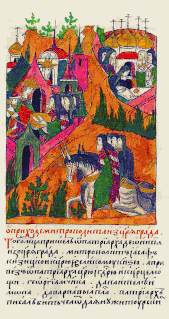Pankratios or Pangratios (Greek : Παγκράτιος) was the first Metropolitan bishop of Trebizond following the Ottoman conquest of the Empire of Trebizond in 1461.

Greek is an independent branch of the Indo-European family of languages, native to Greece, Cyprus and other parts of the Eastern Mediterranean and the Black Sea. It has the longest documented history of any living Indo-European language, spanning more than 3000 years of written records. Its writing system has been the Greek alphabet for the major part of its history; other systems, such as Linear B and the Cypriot syllabary, were used previously. The alphabet arose from the Phoenician script and was in turn the basis of the Latin, Cyrillic, Armenian, Coptic, Gothic, and many other writing systems.

In Christian churches with episcopal polity, the rank of metropolitan bishop, or simply metropolitan, pertains to the diocesan bishop or archbishop of a metropolis.

Trabzon, historically known as Trebizond, is a city on the Black Sea coast of northeastern Turkey and the capital of Trabzon Province. Trabzon, located on the historical Silk Road, became a melting pot of religions, languages and culture for centuries and a trade gateway to Persia in the southeast and the Caucasus to the northeast. The Venetian and Genoese merchants paid visits to Trebizond during the medieval period and sold silk, linen and woolen fabric; the Republic of Genoa had an important merchant colony within the city called Leonkastron that played a role to Trebizond similar to the one Galata played to Constantinople. Trabzon formed the basis of several states in its long history and was the capital city of the Empire of Trebizond between 1204 and 1461. During the early modern period, Trabzon, because of the importance of its port, again became a focal point of trade to Persia and the Caucasus.
Nothing is known about Pankratios' origin or early career prior to his appointment as metropolitan. [1] The see had been vacant since the capture of Trebizond and the incorporation of the Empire of Trebizond to the Ottoman Empire in 1461, as the bulk of the Trapezuntine upper classes, including the secular nobility and the ecclesiastical hierarchy, were transferred to the Ottoman capital, Constantinople. It was not until ca. 1472 that the vacancy was addressed. [2] This was partly the result of the appointment of the Trapezuntine Symeon I as Patriarch of Constantinople, but owed more to political considerations on the part of the Ottoman Sultan, Mehmed II: the Christians of the Pontus region around Trebizond had been restive against Ottoman rule, and were encouraged by the neighbouring Aq Qoyunlu sultan Uzun Hassan. The latter was linked through family ties with the former imperial house of Trebizond, and lent his support to a scion of that house, Alexios Komnenos. In order to counteract the threat of a rebellion, the Sultan elevated Symeon to the patriarchal throne, and he immediately appointed Pankratios to the metropolitan throne of Trebizond. It appears, however, that the latter was unable to satisfy the Sultan's expectations about calming the province, and already after a few months Mehmed II demanded his replacement. Pankratios was succeeded by Dorotheos II, and nothing further is known of him thereafter. [1] [2]

The Siege of Trebizond was the successful siege of the city of Trebizond, capital of the Empire of Trebizond, by the Ottomans under Sultan Mehmed II, which ended on 15 August 1461. The siege was the culmination of a lengthy campaign on the Ottoman side, which involved co-ordinated but independent manoeuvres by a large army and navy. The Trapezuntine defenders had relied on a network of alliances that would provide them with support and manpower when the Ottomans began their siege, but failed at the moment Emperor David Megas Komnenos most needed it.

The Empire of Trebizond or the Trapezuntine Empire was a monarchy and one of three successor rump states of the Byzantine Empire that flourished during the 13th through 15th centuries, consisting of the far northeastern corner of Anatolia and the southern Crimea. The empire was formed in 1204 after the Georgian expedition in Chaldia, commanded by Alexios Komnenos a few weeks before the sack of Constantinople. Alexios later declared himself Emperor and established himself in Trebizond. Alexios and David Komnenos, grandsons and last male descendants of deposed Emperor Andronikos I Komnenos, pressed their claims as "Roman Emperors" against Byzantine Emperor Alexios V Doukas. The later Byzantine emperors, as well as Byzantine authors, such as George Pachymeres, Nicephorus Gregoras and to some extent Trapezuntines such as John Lazaropoulos and Basilios Bessarion, regarded the emperors of Trebizond as the “princes of the Lazes”, while the possession of these "princes" was also called Lazica, in other words, their state was known as the Principality of the Lazes. Thus from the point of view of the Byzantine writers connected with the Laskaris and later with the Palaiologos dynasties, the rulers of Trebizond were not emperors.

The Ottoman Empire, historically known in Western Europe as the Turkish Empire or simply Turkey, was a state that controlled much of Southeast Europe, Western Asia and North Africa between the 14th and early 20th centuries. It was founded at the end of the 13th century in northwestern Anatolia in the town of Söğüt by the Oghuz Turkish tribal leader Osman I. After 1354, the Ottomans crossed into Europe, and with the conquest of the Balkans, the Ottoman beylik was transformed into a transcontinental empire. The Ottomans ended the Byzantine Empire with the 1453 conquest of Constantinople by Mehmed the Conqueror.

